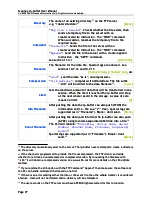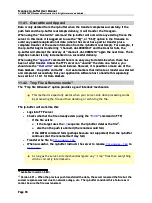
Scannex ip.buffer User Manual
© UK 2007-2021 Scannex Electronics Ltd. All rights reserved worldwide.
11.7. COM port serial
The “COM port serial” delivery option allows pushing the data out through one of the
unused COM ports of the ip.buffer. This allows for collection from TCP/IP devices and
delivery to standard serial equipment or PC ports. With the ip.4 product it is possible to
collect on one COM port and deliver to another.
The COM port serial is output only. Anything transmitted
into
the delivery COM
port will be discarded.
Port
Which COM port to deliver on.
[COMn]
Baud
The baud rate
[19200]
Protocol
The number of data bits and parity.
[8N]
Tx Pin
Which pin to transmit on.
“
Auto
” - automatically detects the DCE/DTE pinout
“
Pin2 (DCE/PC)
” – a straight cable from the ip.buffer to the PC
can be used.
“
Pin3 (DTE/PC+Null)
” – a null-modem cable from the
ip.buffer to the PC should be used.
[Auto]
Tx Flow
Which control lines to monitor when deciding whether we can
send data into the device. The ip.buffer will wait for the
handshake lines to be
asserted for 5 seconds
before
considering the connection “connected” and sending data.
If the handshake lines remain
unasserted for 10 seconds
the ip.buffer will consider the connection closed and
finalise the delivery.
[CTS & DSR]
Tx Size
Determines the maximum chunk size to transmit. The Tx Flow
control lines are only checked before sending each chunk.
If the connected device has a small input buffer and uses
hardware flow control then lower this value
[16]
Tx Pause
Allows insertion of an inter-byte gap on transmission. The value is
measured in bits, so a value of 10 will halve the
transmission speed. Use larger values to slow down the
transmission into slow devices.
[0]
23
Auto requires that both TX and RX be connected to detect the pin-out. For connections with only
TX you must use one of the non-auto modes.
24
When using higher baud rates (e.g. 115200), very small values of Tx Size will cause excessive CPU
load when sending very large amounts of data out of multiple COM ports and may cause the
ip.buffer to reset.
Page 101
Scannex ip.buffer User Manual
© UK 2007-2021 Scannex Electronics Ltd. All rights reserved worldwide.
11.7. COM port serial
The “COM port serial” delivery option allows pushing the data out through one of the
unused COM ports of the ip.buffer. This allows for collection from TCP/IP devices and
delivery to standard serial equipment or PC ports. With the ip.4 product it is possible to
collect on one COM port and deliver to another.
The COM port serial is output only. Anything transmitted
into
the delivery COM
port will be discarded.
Port
Which COM port to deliver on.
[COMn]
Baud
The baud rate
[19200]
Protocol
The number of data bits and parity.
[8N]
Tx Pin
Which pin to transmit on.
“
Auto
” - automatically detects the DCE/DTE pinout
“
Pin2 (DCE/PC)
” – a straight cable from the ip.buffer to the PC
can be used.
“
Pin3 (DTE/PC+Null)
” – a null-modem cable from the
ip.buffer to the PC should be used.
[Auto]
Tx Flow
Which control lines to monitor when deciding whether we can
send data into the device. The ip.buffer will wait for the
handshake lines to be
asserted for 5 seconds
before
considering the connection “connected” and sending data.
If the handshake lines remain
unasserted for 10 seconds
the ip.buffer will consider the connection closed and
finalise the delivery.
[CTS & DSR]
Tx Size
Determines the maximum chunk size to transmit. The Tx Flow
control lines are only checked before sending each chunk.
If the connected device has a small input buffer and uses
hardware flow control then lower this value
[16]
Tx Pause
Allows insertion of an inter-byte gap on transmission. The value is
measured in bits, so a value of 10 will halve the
transmission speed. Use larger values to slow down the
transmission into slow devices.
[0]
23
Auto requires that both TX and RX be connected to detect the pin-out. For connections with only
TX you must use one of the non-auto modes.
24
When using higher baud rates (e.g. 115200), very small values of Tx Size will cause excessive CPU
load when sending very large amounts of data out of multiple COM ports and may cause the
ip.buffer to reset.
Page 101
















































